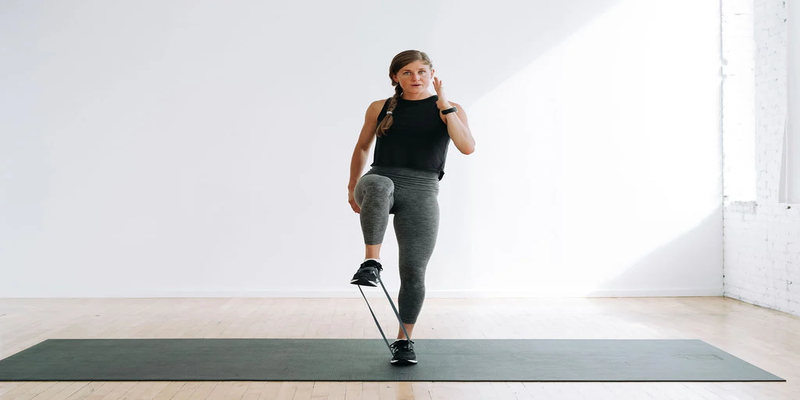Is lunge activity stressing your knees, and you still want to fix your hip flexors? If yes, you can perform the one lunge variation thats safest for your knees: reverse lunge. It helps to restore the gluteal muscles and hip flexors while lessening the pressure on your knees.
Some people experience severe pain in their knees while performing the lunges due to sudden pressure that is unevenly applied on the front leg. To avoid this condition, you can try reverse lunges that allow a shorter range of motion for the knee to adjust accordingly.
The muscles of your lower body work together and distribute the burden evenly. It happens when you perform the exercise by stepping backwards and bending the front leg at the right angle while keeping your trunk straight and well-aligned.
Scroll down to discover more!

Below is the proper lunge form and technique to perform the one lunge variation thats safest for your knees: reverse lunges. Following these steps will help your knee to stay safe and painless.

Reverse lunges are the best alternative for hectic lunges, yet they are practical and powerful exercises that boost the gluteal muscles. You will feel significant benefits of practicing reverse lunges on your knee health, especially if you are trying to get rid of knee pain.
Practicing reverse lunges enhances the strength of quadricep muscles to protect knee joints. This reduces the risk of injury and pain, improving the quality of movement.
This exercise increases the production level of synovial fluid, which further stimulates the improvement of joint lubrication. This way, your joints move smoothly and painlessly by reducing the friction.
Safe strength training of the one lunge variation that's safest for your knees, reverse lunges, enhances the mobility of lower body joints like ankle, knee, and hip joints.
Reverse lunge is one of the knee-friendly exercises that allows the knee muscles to move freely within a short range of motion. This type of movement maintains the balance and keeps the knee joint stable.

If you want to practice the one lunge variation that's safest for your knees, you can apply various changes to the exercise if it is still painful. If you feel reverse lunges as a complex activity, you can modify some moves to make it safer and painless for your knees.
The beginners can keep one hand on the wall or chair for better stability. This will help to reduce pressure on the knees. Choosing a lesser number of repetitions can avoid overworking the knee joints. You don't need to be harsh on your knees.
If you want to make progress in practicing reverse lunges while keeping your knees safe, you must keep the following tips in mind:
Exercising for a short period will make your knees weaker and make it painful to move. You need to practice reverse lunges regularly to strengthen your knees and avoid knee injuries.
Focus on the formula of quality rather than quantity to keep your knees safe. The quantity won't matter if you are doing it wrong. Doing it right and for less time will be more effective for your knees.
Always consider your knee stamina and needs. If your knee joints feel tired or pain in any gluteal muscle beyond normal, stop immediately and rest to ease your knees. Consult a health physician if necessary.
Before opting for the one lunge variation thats safest for your knees, you must know the difference between the two. Although reverse and forward lunges are similar in many ways, some differences exist.
Forward lunges begin with moving the leg forward, putting more weight on the knee. While reverse lunges focus on moving the leg backwards, which keeps the weight equal on the front and back knees.
Forward lunges focus on pressurizing the front quadriceps, which ultimately stresses the knee joint. On the other hand, reverse lunges strengthen the gluteal muscles and hamstrings, which reduces the stress on the knees.
Forward lunges cause more pain in knee joints by stressing out the knee. Reverse lunges distribute the stress equally, minimizing knee pain.
This article uncovers the one lunge variation thats safest for your knees: reverse lunges. They are easy to practice and prevent knee valgus through controlled movement and balance.
Reverse lunges protect and strengthen the surrounding muscles to allow smooth movement!

By Celia Shatzman/Sep 20, 2024

By Elena Davis/Sep 25, 2024

By Darnell Malan/Sep 25, 2024

By Maurice Oliver/Sep 20, 2024

By Noa Ensign/Sep 20, 2024

By Susan Kelly/Aug 24, 2024

By Martina Wlison/Sep 21, 2024

By Martina Wlison/Sep 20, 2024

By Christin Shatzman/Sep 25, 2024

By Juliana Daniel/Sep 26, 2024

By Pamela Andrew/Sep 25, 2024

By Juliana Daniel/Sep 25, 2024